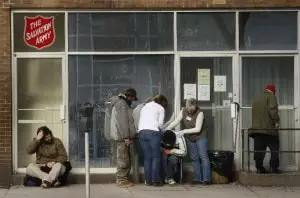
*Intern Emily Shoff “Engage’s Ottawa” on poverty issues
The journey has begun. Phase 1: start to rid the stereotypes associated with poverty and understand why they exist. The Salvation Army (SA), an organization dedicated to assisting vulnerable individuals and families, will help us with this task.
What does a home provide? A sense of security, safety, warmth, independence, dignity, trust, the list goes on. To live in the comfort of our very own home enables us to live life. Period.
Living without a permanent residence is classified as homelessness. Not only does it mean to live without a home, it means to live on the streets, in a shelter, an inhabitable location or to couch surf (living with friends or family for a temporary period of time). This definition immediately broadens the number of people who are struggling.
SA confronts homelessness and the issues that have accompanied it since 1865. The particular location in which myself and Kizzy, a Canada Without Poverty colleague, visited was the Emergency Shelter downtown Ottawa that offers shelter to homeless men specifically. Here, the SA emphasizes a ‘housing first approach’ with both their Outreach Street Services and Housing Response Team.
What a ‘housing first approach’ theorizes is that by providing a home, aka, a sense of security, independence, will power, etc. is a crucial step and furthermore one of the first to aiding mental health, addictions and helping to improve employment and educational attainment.
Outreach Street Services helps to counter the shelter’s stereotype. The Outreach Van “meets clients where they are, both physically and mentally”. The service operates 7 days a week from 11am-3am and in extreme weather conditions 24/7. The primary role of the Outreach Van is to provide transportation to safe shelter. Individuals are also given a choice. If one refuses transportation, the Outreach Van will offer basic necessities such as socks, water, sleeping bags and more to align with a ‘harm-reduction approach’, which is empowerment centred.
Standing in the foyer of SA, waiting to meet with the Co-ordinator of Outreach Services, men of all ages are entering and exiting the emergency shelter. This is extreme poverty. The emergency shelter holds 150-180 men, some who need special care and might reside at the shelter for the remainder of their lives and some who need “a place of new beginnings”, one of SA’s mottos. As Kizzy and I listen to the un-told stories, it becomes clear that poverty has become an immediate side effect of what many homeless people have experienced: trauma.
Unfortunately with the pronounced stereotypes of the “lazy bum” and the “drunk” we have brainwashed our own beliefs while creating an environment where our natural reaction is cause people who are homeless to feel shame. These false impressions of laziness further deteriorates an individual’s self-esteem and thus keeps them from receiving support from organizations like SA because they are too embarrassed to ask for help. And so the organizations that intend to assist the homeless can be associated with an image of desperation and worthlessness.
It takes a lot of will power to admit you need help. It especially takes a lot of will power to admit yourself into an emergency shelter – almost a wake–up call that life has become so unbearable you must depend on an organization to aid you. It may seem like an easy decision to receive aid from those who offer it, but in a world that places shame on these individuals, it is not an easy task admitting to need help.
This is not the fault of SA, but of civil society’s, one that has existed since the Elizabethan Poor Laws in the 1600s. If we, as a civil society can omit these stereotypes then maybe those individual’s in desperate situations will feel less epitomized and thus grab hold of the helping hand, shame-free.
To fall, one must have been pushed by a life’s occurrence that has ultimately turned into a force of inexplicable recovery. The road to stability is one that involves the aid of an organization such as SA to offer immediate care. Visiting with SA challenged my own understanding of homelessness to not be about the “lazy bum” but of struggle and difficulty of obtaining help.
While SA works on the front-line lifting those up off the ground, CWP strives to ensure they can be further lifted above the poverty line with government involvement. The two organizations differ in their function (SA provides a service, CWP addresses the systemic causes of poverty) but both believe in the dignity of all human beings to and have a common goal of ending poverty. With projects like CWP’s Engage Ottawa, and our other activities that work to raise awareness of the general public’s understanding of poverty and homelessness, we may in turn encourage those in need to receive assistance, and hopefully end the cycle of poverty that traps so many. So let us end the recurring stereotypes. It is time to look beneath the surface of poverty and see the person who is just like us.

